Pitcher Perfect in Paris
The Indy Goes to Fashion Week
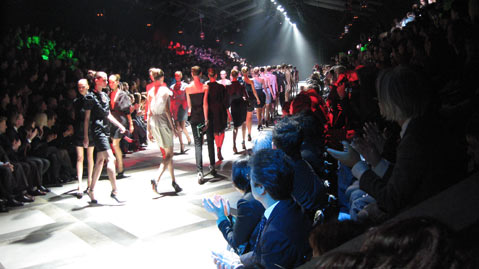
When glamorous Susan Pitcher, owner of two of Coast Village’s chicest boutiques, invited The Indy’s style editor to join her on a retail buying trip during Fashion Week in Paris, L.D. Porter jumped at the chance, cashing in her frequent flier miles and packing every black thing she owned except the cat. What follows are brief vignettes from her Paris journal where she recorded the most grueling, exhausting, intimidating, and exhilarating week of her life.
Bonne Chance
Oh, I know the Paris shows aren’t what they used to be: gilded chairs with discrete clientele and white-gloved elegance. Nowadays, it’s all ready-to-wear, celebrity flash, and sell, sell, sell. Nevertheless, I was thrilled to death when Susan, who seldom goes to runway shows-she’s much too busy working away in designer showrooms-managed to snag me tickets for two coveted shows: Stella McCartney and Lanvin. (Susan’s stores, dressed and ready, are the only boutiques in town that carry these two important lines.) As you can imagine, invitations to such events are not easy to come by. It’s like having the best seat at a prominent table in a posh restaurant-luck did not get you there.
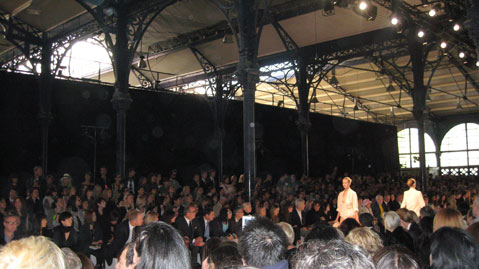
Stella!
My Stella McCartney runway show invitation included a miniature megaphone that made my voice sound like a robot, and I certainly felt like one when I boarded the Paris Metro at 8 a.m. the morning of the show. It never occurred to me that fashion shows would take place before noon, but apparently Stella is an early riser.
I left extra early to ensure I would arrive well before the appointed hour. The show was in the oldest section of Paris, the Marais. As I exited the Metro, I noticed a long line of stalled traffic on a one-way side street. Many of the passengers, all chicly dressed and clearly irritated, were getting out-the women wearing amazingly high, high heels-and walking determinedly up the Rue de Thouars. I realized I wouldn’t need my map, and followed the tottering fashion pack to a 19th-century iron-and-glass-covered marketplace where a crowd slowly was gathering. A stylish young man with an earphone was stationed at the doorway, nodding to the few people who were presenting their invitations for entry. Outside, the place looked cold and dark, but inside it was a huge airy space with concrete floors. I immediately was drawn to a series of tables laden with my favorite food groups: champagne, coffee, and chocolate truffles spelling out “Stella.” No one, inside or out, seemed particularly concerned about time.
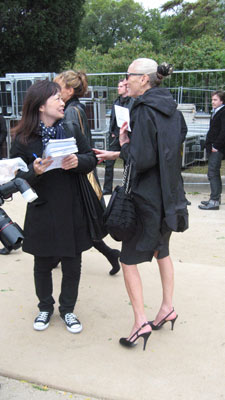
The runway stretched down the center of the building between two parallel sets of bleachers covered in white fabric. I soon found my seat, but quickly realized almost no one else was sitting down. Chicly dressed people continued to wander in leisurely, joining little groups standing around chatting idly. They greeted each other with air kisses.
I noticed a single line forming in front of a closed door on the far side of the room: les toilettes! I happily joined this group. The line moved at a glacial pace. A middle-aged man emerged and gestured to those waiting that he was slitting his throat. The wait, it seemed, was not going to be worth it. I finally reached the front of the line when a troika of lanky, tall, and extremely young women with tightly pulled blonde ponytails loped up to me: “Can we go first? We’re in the show.” I continued waiting.
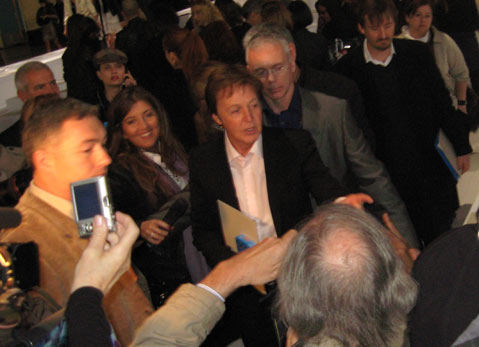
Sir Paul at 64
As the last model disappeared into the wings to the familiar voice of Paul McCartney singing “Maybe I’m Amazed,” Stella McCartney appeared on the runway dressed in an oversized blazer (her feminine take on an English suit coat nicknamed the “boyfriend jacket”) that’s a familiar staple in Susan’s stores. Hair pulled back in a ponytail, Stella looked like a shorter version of the eerily identical models who had just whizzed down the runway wearing the collection she designed for spring 2009. After her quick bow and exit, the audience stood up, and the photographers, in a feeding frenzy of flashbulbs and microphones, lunged at Paul McCartney, who had watched his daughter’s show from a front-row seat. Moving like an amoeba, Sir Paul and the attached paparazzi flowed toward the exit and into the bright light of the chilly Paris morning.
Susan Pitcher On Topic

Occupation: Owner of dressed and ready boutiques on lower Coast Village Road.
Describe your style: Clean, sexy, fun, functional, and feminine in a modern way.
What is your earliest fashion memory? My parents led a very glamorous life in New York. My mother, who always had amazing style, would appear in the doorway of my bedroom before she went out for the evening to ask me how she looked. I would appraise her from her makeup down to her shoes-an unusual exercise for a young girl, I admit-but I attribute my critical eye and understanding of fit, color, shape, and style to those times.
Who is your style icon? Audrey Hepburn in the opening scene of Breakfast at Tiffany’s, gazing at the store’s windows with a tiara on her head, a coffee in her hand, and a dream in her heart. She epitomizes all the elegance and glamour of New York.
What’s the most cherished item in your closet? My father’s favorite cufflink that my son had made into a ring for me.
What is one thing you’ll never be caught dead in? A string bikini.
Where do you shop in Santa Barbara? At dressed and ready, of course.
Grace Under Pressure
Once we started making the rounds of the designer showrooms, Susan’s retail prowess and physical stamina quickly emerged. She had scheduled appointments with at least two showrooms per day, which might not sound like much to the uninitiated. In fact, I had pictured the two of us sharing a leisurely lunch each day at a cafe on the Avenue des Champs-lysees. How was I to know that showroom appointments can last as long as five hours? Luckily, most showrooms provided food. And drink.
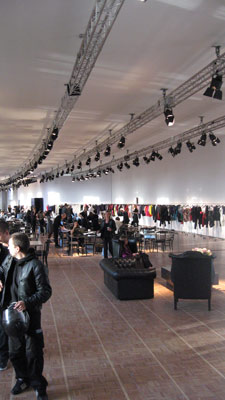
Our first appointment started at 9 a.m. and we quickly got down to work. The routine was always the same. A sales assistant escorted us to the clothing racks and explained the “theme” of the collection, which was the designer’s overall vision for the season. At the Lanvin showroom, for example, our sales assistant told us the clothing for the spring 2009 collection was simple and unadorned, because, in the mind of Lanvin’s designer Alber Elbaz, “the jewels are beneath the table.” Translation: The shoes sparkle like jewelry so the clothes don’t need to. (Although in this case, Elbaz’s clothes, in their vibrantly colored fabrics, were so magnificently designed that they were jewels themselves.)
As the sales assistant guided us through the throng of clothing racks, Susan would quickly select items that interested her, and then we would sit at a table and wait. Within a couple of minutes, a model appeared wearing one of the outfits Susan had selected. Firmly but politely, Susan would ask each model to sit down, stand up, turn around and raise her hands, and sit back down again. It suddenly dawned on me: Susan was test-driving each item to make sure her clients would be able to wear it comfortably in real life. As I learned, even a garment that looks great on a live model can have structural problems. (In one showroom, a model came out in a dress that so restricted her arms she could only flap her hands like a fish stranded on shore.)
After the model exercise, Susan would then seriously study the garment up close, examining the seams, lining, zippers, and fabric. Then Susan and I would both photograph the model from every angle with our digital cameras. Out came the next model. When Susan had seen all of her selections, it was accessory time. This was always fun, because we actually got to try on the jewelry and shoes and hold the handbags. (Returning everything was harder.)
Finally, after what seemed like an eternity, Susan would sit down with the sales assistant to make her order. We saw so many clothes, bags, shoes, and jewelry at each house that my mind was practically spinning; yet Susan remained totally calm and collected. Not only did she mentally keep track of each design she wanted to order, she had already evaluated which of the outfits would suit specific clients. The sheer amount of detail she kept track of on a daily basis was mind-boggling.
And this was only part of the picture. The stakes in the fashion business are always incredibly high; but imagine the prospect of committing to buy thousands of dollars of clothing in the midst of an uncertain economy. Susan’s unwavering concentration and determination showed me that she’s a true believer: in the art of fashion and in the industry she so faithfully represents. Susan never forgets that behind each piece of clothing she sells in her stores there are hundreds of workers whose job it is to create reality out of a designer’s creative vision by cutting the fabric, sewing the seams, and placing the zippers.
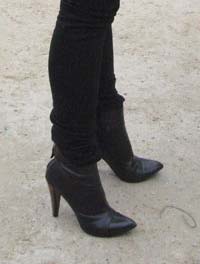
Walk a Mile in My Manolos
After three days visiting showrooms with Susan, I was exhausted, my feet hurt, and I had run out of clean clothes. But Susan, like a professional athlete, continued on, cool, collected, and dressed to perfection. When we visited the Lanvin showroom, she wore her Lanvin ensemble; when we visited the Stella McCartney showroom, she wore Stella McCartney. And she thought nothing of wearing high heels all day, every day.
She is one of those women who can walk through life in four-inch heels as if they’re wearing running shoes. Not me, though I never gave up the concept of myself in high heels, which was why I brought a new pair of black high-heeled boots to Paris. Of course, my faithful but ugly walking shoes went in as well (my dedication to fashion has its limits). In contrast to Susan, my daily outfit remained the same: black shirt, black skirt, designer unknown; but I did make an effort in the shoe department. As we approached each designer’s showroom, I would whip out my black high-heeled boots from my purse and simultaneously stuff in my ugly stepsister walking shoes, which is how I found myself hopping around on one foot on the ultrachic Avenue Montaigne to the bemusement of the elegant passers-by. (Luckily, Susan also has a sense of humor.)
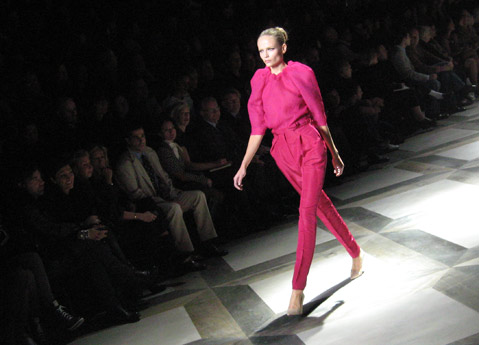
The Motos of Lanvin
I’d been instructed to pick up my invitation to the Lanvin runway show at the Lanvin store near the Place de la Concorde. High-end designer stores in Paris are like high-end art galleries. Everything is very, very quiet. All of the clothes are displayed like art. The salespeople stand at attention, and talk very quietly. I entered the store and announced (probably too loudly) that I was there to pick up my invitation. I was quickly sent around to the office.
It was raining as I trudged along an endless block until I reached what appeared to be a service entrance. Inside, a long, starkly lit hallway led to a small glass-walled vestibule where I spent quite some time trying to explain to a guard why I was there. All around us, people were coming and going. Deliverymen dropped off enticing looking garment bags and shoeboxes. Then two of the tallest, thinnest girls I’ve ever seen strode toward me. “We’re here to see Alber!” the two models chimed in unison, and up the freight elevator they went to meet Lanvin’s designer, Alber Elbaz.
All at once, the moto boys arrived. Young men, dressed from head to toe in black leather and carrying big shiny motorcycle helmets walked-well, it was really more of a swagger-down the hall. One at a time, they presented themselves at the window and received a stack of big envelopes from the guard. The invitations! I was at the center of the invitation nucleus. The moto boys lingered for an instant, checking the GPS function on their cell phones to be sure where they’d be going. I pictured them fanning out all over Paris like shiny black beetles delivering the priceless invitations to the lucky few. I craned my neck to see if I could read the names on the envelopes, but all I got for my efforts were suspicious looks. Finally, the guard handed me mine.
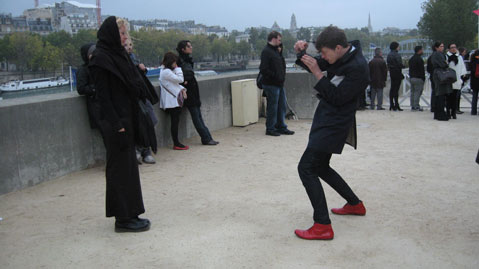
Monday Night Fashion
After waiting a drizzly hour outside the white tent erected on the banks of the Seine within spitting distance of the Eiffel Tower, the bouncers checked my invitation and motioned me inside. It was like entering a packed sauna fully clothed. The term “standing-room only” suddenly made complete sense, because that’s all I was able to do. Stand. I couldn’t really see anything. I was in a fashion moshpit.
The music was deafening. The lights turned off and on and then out came the models, dressed to perfection in Lanvin. They walked like automatons: hips first, in that impossible-to-imitate-but-universally-recognizable model walk. They stared straight ahead, expressionless. When each model reached the end zone of flashing camera strobes, she paused for a brief instant, slyly acknowledging the photographers’ collective presence. I held my digital camera above my head, aimed it in the direction of the runway and took pictures blindly.
Within minutes, it was over. The final parade of models came out all at once, the team taking its victory lap. I heard the crowd roar and realized that Alber, the team’s coach, was taking his bow. My heart raced. It was an epiphany. I finally understood on a gut level what had escaped me all my life: the visceral thrill of professional sports. So this is what causes men to turn into couch potatoes and frequent sports bars! Picture this: Monday night fashion. Women crowding into bars, drinking champagne, and cheering for their favorite designers while munching on chocolate truffles. Sign me up.
My First Paris Gown

The glamour of Paris collections is long gone for my generation. Today’s major names-Dior, Balmain, Givenchy-mean dresses designed by someone totally different and produced in the thousands. In 1953, when I first attended the Paris haute couture showings, there were four seasonal collections a year. You had to be a client or recommended by the American Embassy to reserve a seat for a scheduled showing. Once there, a vendeuse, whose duty it was to oversee your entire visit, would show you to your assigned little gold chair beside the lengthy runway. There were no intrusive paparazzi blocking your view. The showing started promptly. Each model was announced by the name of her gown. Soft music played. She moved gracefully down the runway, making special turns in front of patrons such as the legendary Begum Aga Khan, who sat directly across from me at the Givenchy that year, wearing the most tremendous emeralds. You’d mark the gowns you wished to see again on your little program with the attached small pencil. After the wedding gown was shown, gorgeous young Hubert de Givenchy made a turn down the runway to much applause. Your vendeuse then took you to a private room where models wearing the creations you had marked came to offer a closer look. Selections made, your measurements were carefully taken. In the following days, you would return for three tiring fittings needed to achieve the perfection of a creation from Paris haute couture. This was the way it was at all the houses. I’ll never forget Black Magic, my first Paris gown from Jacques Fath. -Beverley Jackson



